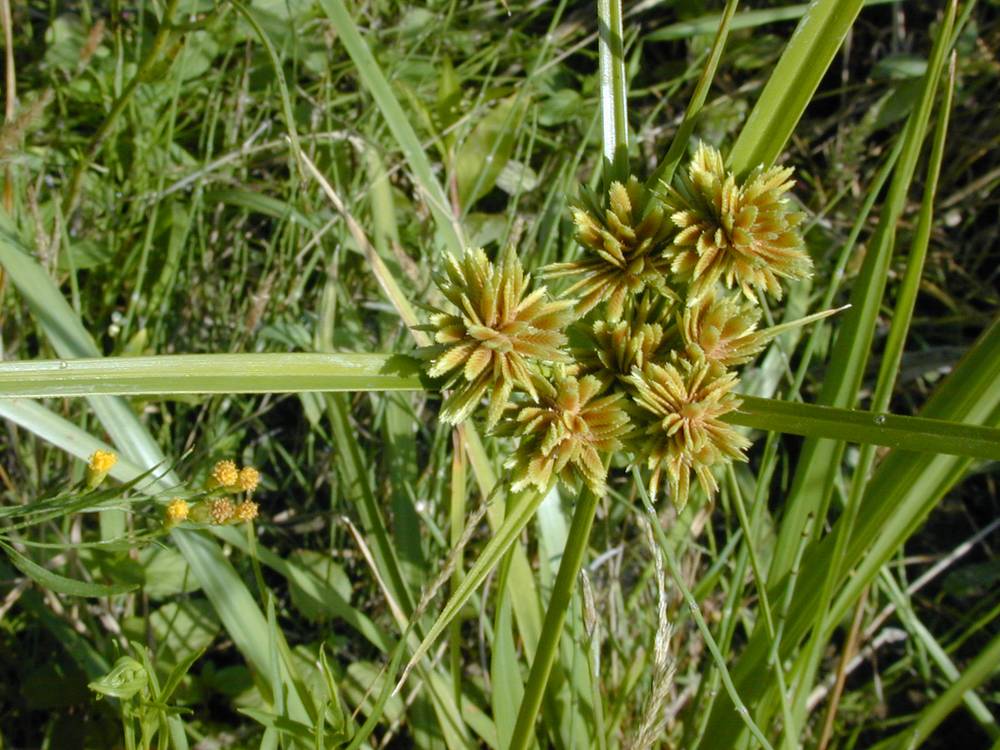Cyperus niger
Cyperus
black flatsedge
flatsedge, umbrella-sedge
5–40(95) cm.
solitary or clustered, trigonous or round.
3–20(30) cm × 1.5– 3 mm.
usually basal;
ligules absent;
blades keeled abaxially; flat; V-, or M-shaped in cross section.
clusters densely head-like; ovoid to hemispheric, 7–16(20) mm diameter;
rays (0)1–2, 0.3–4.5 cm;
inflorescence bracts 2–3; horizontal to reflexed downward.
terminal; the spikes either all arising close to one another in head-like clusters or arising separately in cylindrical clusters; some or all clusters usually raised on stalks (rays) (0)2–12(30) cm; if rays absent inflorescence a dense often lobed head of overlapping spikes; secondary rays sometimes present
(3)5–25(60), linear to oblong-linear, compressed; (3)5–9 × 1.8–2.3 mm; floral scales 4–18, closely imbricate; ovate to orbiculate, 1.5–2.1 × 1.4–2.2 mm; chestnut brown; black, or brown, medially green or greenish brown, laterally ribless, medially 2(3)-ribbed, distinctly 2-keeled basally;
apex obtuse.
scales to 76, 2-ranked; each subtending a flower, cylindric to compressed; borne spicately or digitately at ends of rays.
anthers 0.6–0.8 mm;
styles 0.4–0.6 mm;
stigmas 0.7–2.1 mm.
bisexual; in axils of floral scales;
scale bases often decurrent onto rachilla as more or less hyaline wings;
perianth bristles absent;
stamens 1–3;
style base deciduous or persistent;
stigmas 2–3.
ellipsoid, 1.2–1.4 × 0.6–0.8 mm, with network of ridges forming isodiametric or square cells.
biconvex, flattened, or trigonous.
clusters 1–80;
rays usually unequal in length, produced singly from the axils of inflorescence bracts;
involucral bracts 2–12(25), 1–50 cm long, spirally arranged at culm apex, spreading to erect; leaf-like.
Cyperus niger
Cyperus
Swamps, ditches, wet meadows. 50–100 m. CR. CA; east to Oklahoma; South America. Exotic.
Cyperus niger is commonly collected without rhizomes and therefore confused with the similar but shorter C. bipartitus. Cyperus niger is variable, and as many as six varieties have been recognized, but the pattern of variation seems too complex to fit into simple taxonomic categories.
Cosmopolitan in tropical and temperate areas. Approximately 600 species; 10 species treated in Flora.
Cyperus is characterized by terminal inflorescences and usually flat spikes with 2-ranked scales. Cyperus aggregatus was collected in Oregon in 1916 and C. odoratus in 1915. Both were found on ballast in Linnton (Multnomah County).
Barbara Wilson, Richard Brainerd, Nick Otting
Barbara Wilson, Richard Brainerd, Nick Otting
- Local floras:
CA,
OR,
WA
- Local Web sites:
CalFlora,
CalPhotos,
Flora NW,
PNW Herbaria
WildflowerSearch
iNaturalist (observations)
USDA Plants Database
- LBJ Wildflower Center
- SEINet
- Plants of the World Online
- Encyclopedia of Life
- Wikipedia
- Google Image Search



